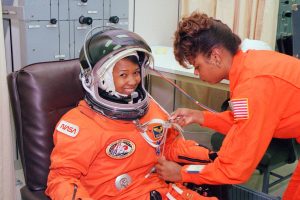December 2, 2016
Dressing for (Interview) Success
Posted by AGU Career Center
By David Harwell
Earth and space scientists have a style all their own, and without getting judgmental, let’s just agree that it is not the right style for most interviews. It is important to wear the right clothing for the situation. For example, in the photo below, Dr. Mae Jemison looks great in orange; however, while a space suit is appropriate for a trip into space and broken-in blue jeans might be the right fit for work in the field, neither makes the cut of things that you should wear to an interview. Here are a few guidelines to help you choose the right garments for the big day.

NASA astronaut Mae Jemison waits as her suit technician, Sharon McDougle, performs an unpressurized and pressurized leak check on her spacesuit at the Operations and Checkout Building at Kennedy Space Center in Florida.
Photo Credit: NASA
My mama always said, “You can always dress down, but you can never dress up.” What she meant is that it is better to overdress than to underdress. If you show up for an interview in a less than appropriate outfit, you will have blown your chance to make a good first impression. If you are overdressed for the occasion, you can always take off your tie, or switch out your shoes to something more appropriate. You still will have made a good first impression.
Oh, wait, here it comes. I can feel the Internet buzzing with a response already: “I don’t want to dress up too much, because I want them to know that I am willing to get dirty. I want to show them that I’m not too good to do fieldwork.” Fine. You can put your field outfit in your appropriately festooned backpack so that you can show them that you know how to dress for the field—just don’t wear it to the interview.
Dressing up for an interview is done to show respect for the interviewer. Anything less, and you are signaling to the recruiter that you don’t really care about them or their job. Dressing well also gives you a chance to show your abilities to act appropriately in the workplace and to pay attention to detail, as well as your potential to represent the hiring organization.
At a recent career fair, I talked to a recruiter who was looking for a technical sales representative for her company. I had sent several qualified bachelors-level candidates her way, and I wanted to know whether any of them were satisfactory. Unfortunately, she said that none of them were right for the job—they were not professional enough to represent the company. They were “more likely to run business away than to attract it.”
What is the right outfit for interview success?
Gentlemen should wear dress pants and a dress shirt. Khakis are okay; jeans are not. The shirt should have a collar and should button all the way up the front. You will also need a tie, a belt, dress shoes, and a sport jacket. Alternatively, you could wear a suit.
Ladies have a little more freedom when it comes to their interview outfits. You can wear slacks, a skirt, or a dress. You can wear a suit, a jacket, or a sweater. The defining parameter is that it should look professional, and when in doubt, go conservative.
For either sex, remember that most of your skin should be covered. Your trousers shouldn’t droop, your undergarments shouldn’t show, and your neckline shouldn’t plunge.
Both you and the person interviewing you should be focused on your capabilities as a scientist and how those capabilities map to the needs of the organization where you are hoping to work. Your outfit shouldn’t be what they remember about you. It should be what they expect (no better or no worse), so that they mentally check that requirement off their list, and they focus their attention on you.
David Harwell is the Assistant Director of Talent Pool at the American Geophysical Union.


 On the Job is an AGU blog, that provides career advice and workforce guidance to geoscience students, early-career and established professionals who are interested in pursuing professional enrichment.
On the Job is an AGU blog, that provides career advice and workforce guidance to geoscience students, early-career and established professionals who are interested in pursuing professional enrichment.
[…] Dress the way you would for an interview. Even though you are only attending a career fair, remember that it’s a long week. These recruiters came to find candidates for the positions that their organization needs to fill. Many job application processes involve an initial screening interview to shorten a list of candidates. You should treat the career fair like a series of screening interviews, and dress accordingly. If you treat the career fair like an informal interview, you might just find yourself in a formal one later in the week. […]
Dressing on interview helps to upgrade yourself and the dressing sense make you feel comfortable during interview.